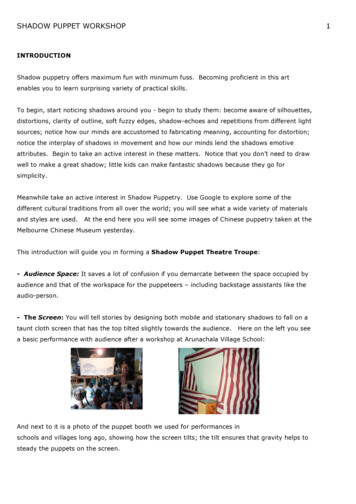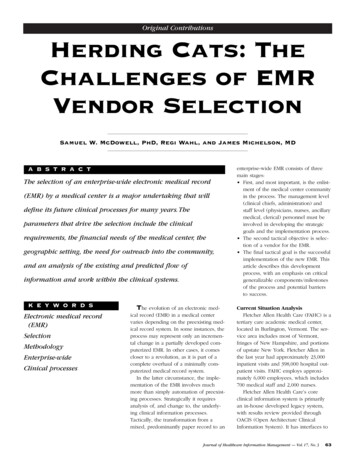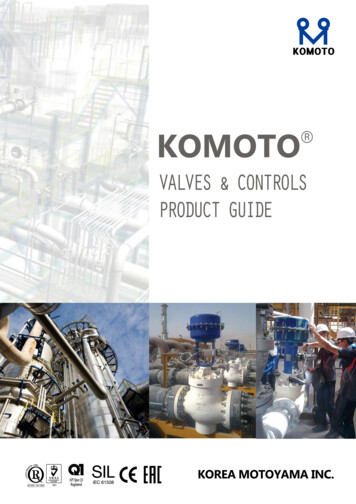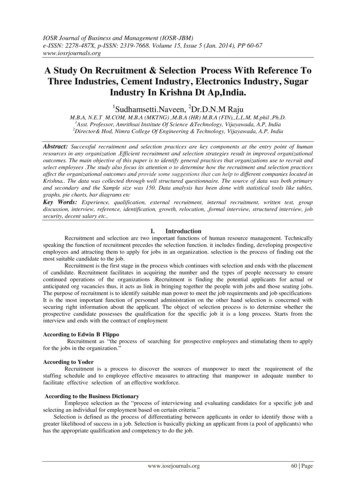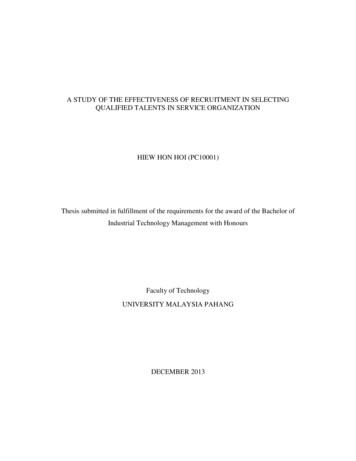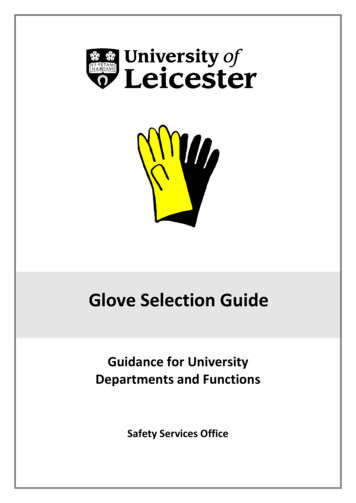
Transcription
Glove Selection GuideGuidance for UniversityDepartments and FunctionsSafety Services Office
Glove selection guideSection titleGloves as Personal Protective EquipmentDefinitions related to glove standardsGlove materialsChemical resistanceUse with biological agentsDisposable vs re-useable glovesGloves for incidental and extended contactGlove selection chartsReferencesPage number112345568Appendices:Appendix 1: SUMMARY: GENERAL RULES FOR HAND PROTECTION *9Appendix 2: CORRECT USE OF GLOVES10Appendix 3: EXAMPLE OF A GLOVE SELECTION (CHEMICAL RESISTANCE)CHART11* Please note this appendix covers a single page and can easily be copied forinclusion in local departmental documentation.
Gloves as Personal Protective EquipmentThe Personal Protective Equipment (PPE) at Work Regulations 1992 require that:“Every employer shall ensure that suitable personal protective equipment is provided to hisemployees who may be exposed to a risk to their health or safety while at work except whereand to the extent that such risk has been adequately controlled by other means which are equallyor more effective.”PPE is always the “last resort” in a hierarchy of control measures, i.e. engineering controls and safesystems of work should always be considered first. This is because:Gloves only protect the wearer – they do not remove the contaminant from the workplaceIf protective gloves are used incorrectly, or are badly maintained, the wearer may not beprotectedGloves themselves can cause skin problemsWearing gloves interferes with the wearers sense of touchThe extent of protection depends on a good fitSome types of gloves are inconvenient and interfere with the way people workIn any given situation, it is important to establish the exact purpose of a protective glove:Is a glove needed at all?Is a glove needed just to keep the hands clean?Is it for protection against heat, cold, abrasion or cuts?Is it for protection against chemicals?Is it for protection against blood-borne viruses?Is it for protection against laboratory animal allergens?Definitions relating to glove standardsPermeation rate is the rate at which the chemical will move through the material. It is measured ina laboratory and is expressed in units such as milligrams per square metre per second, or someother [weight of chemical] per [unit area of material] per [unit of time]. The higher the permeationrate, the faster the chemical will move through the material. The process of permeation continueseven when the glove is no longer in contact with the chemical.Users should be aware that when a glove has been in contact with a chemical, the glove will tosome extent be infiltrated with the chemical due to permeation.Permeation is different from penetration. Penetration occurs when the chemical leaks throughseams, pinholes and other imperfections in the material: permeation occurs when the chemicaldiffuses or travels through intact material.Breakthrough time is the time it takes a chemical to permeate completely through the material. Itis determined by applying the chemical on the glove exterior and measuring the time it takes todetect the chemical on the inside surface. The sensitivity of the analytical instruments used in these1
measurements influence when a chemical is first detected. The breakthrough time gives someindication of how long a glove can be used before the chemical will permeate through the material.Degradation is a measurement of the physical deterioration of the material due to contact with achemical. The material may get harder, stiffer, more brittle, softer, weaker or may swell. The worstexample is that the material may actually dissolve in the chemical.Glove materialsSelection of glove materials should be based on quantitative information such as permeation rate,breakthrough time, penetration and degradation. Various factors like the thickness of the material,manufacturing methods, and product quality control can have a significant effect on theseproperties.For a given thickness, the type of polymer selected has the greatest influence on the level ofchemical protection. For a given polymer an increase in thickness will result in a higher level ofprotection. A rule of thumb is that double the thickness will quadruple the breakthrough time.The manufacturing process of glove making may result in slight variations in performance. The useris warned to exercise care and to check the glove regularly for breakthrough and diminishedphysical performance.Some of the more common glove materials are:butyl - a synthetic rubber with good resistance to weathering and a wide variety ofchemicals.latex (natural rubber) - a highly flexible and conforming material made from a liquid tappedfrom rubber plants. Also referred to as NRL.neoprene - a synthetic rubber having chemical and wear-resistance properties superior tothose of natural rubber.nitrile - a copolymer available in a wide range of acrylonitrile (propane nitrile) content;chemical resistance and stiffness increase with higher acrylonitrile content. Also called NBRor HNBR.polyethylene - a fairly chemical-resistant material used as a freestanding film or a fabriccoating.polyvinyl alcohol - a water-soluble polymer that exhibits exceptional resistance to manyorganic solvents that rapidly permeate most rubbers. Not to be used with aqueoussolutions.polyvinyl chloride - a stiff polymer that is made softer and more suitable for protectiveclothing applications by the addition of plasticizers. Also called vinyl or PVC.polyurethane - an abrasion-resistant rubber that is either coated onto fabrics or formed intogloves or boots.Viton - a registered trademark of DuPont, it is a highly chemical-resistant but expensivesynthetic elastomer.2
For a few specific situations when it is impossible to predict the variety of hazards, multi-laminategloves made of layers of several different materials are available.Of these materials, the most commonly used gloves in laboratories are latex and nitrile:Latex glovesLatex disposable gloves offer no worthwhile protection against many commonly used chemicals.They will severely degrade, often in a matter of seconds or minutes, when used with somechemicals (e.g. turpentine).An estimated 8-12% of the population are allergic to latex products, and staff required to wearlatex gloves should receive training on the potential health effects. If latex is required, hypoallergenic, non-powdered gloves should be used.The use of disposable latex gloves is only appropriate for:Most biological materials including laboratory animal allergens;Non-hazardous chemicals;Very dilute, aqueous solutions of hazardous chemicals: Less than 1% for most hazardouschemicals or less than 0.1% if a known or suspect human carcinogen is in use in aqueoussolution;Clean work area requirements;Medical, veterinary and animal husbandry applications.Do not wear latex gloves if you have or think you are susceptible to a latexallergy. Any indication of possible latex allergy must be reported to the Headof Department and the Safety Services OfficeNitrile glovesNitrile disposable gloves are more durable and provide a clearer indication when they tear or break.They also offer a better set of chemical resistances and are less allergenic. In all cases single use,surgical or examination type nitrile gloves can be substituted for latex gloves.Chemical resistanceThe selection of the proper chemical-resistant glove begins with an evaluation of the task to beundertaken. Factors that influence this selection are:the type of chemicals to be handled;frequency and duration of chemical contact – longer exposure time will shorten thebreakthrough time;nature of contact (total immersion or splash only);concentration of chemicals;temperature of chemicals – higher temperature will shorten the breakthrough time;abrasion-resistance requirements;3
puncture-, snag-, tear-, and cut-resistance requirements;length of hand and arm to be protected (hand only, forearm etc.);dexterity requirements - this need may significantly limit the thickness of glove material thatcan be used;grip requirements (dry grip, wet grip, oily) - the requirement for textured or non-slipsurfaces to improve grip must be considered;cuff edge (plain, knit wrist, gauntlet);colour requirements (to show contamination);thermal protection;size and comfort requirements;price.For mixtures and formulated products, the glove should be selected for maximum protectionagainst the chemical component with the shortest breakthrough time (unless specific test data areavailable). Care should be taken to select a glove material that is compatible with all thecomponents.Use with biological agentsThe testing methodology outlined in the 2003 EU standards is sufficient for demonstrating a barrierto bacteria and fungi, but not viruses. If gloves have been tested for resistance to bacteria andfungi (and passed) they have ‘EN374-2: 2003’ displayed on the box, with the associated biohazardsymbol and further details on the grading of the pass.To be tested for viral penetration, gloves must go through ASTM F1671-97b testing, which is anAmerican standard test method. These tests use Phi-X174 bacteriophage penetration as a testsystem. The Phi-X174 bacteriophage is one of the smallest known viruses at 25-27 nm in size (forcomparison: Hepatitis B is 42-47 nm and the HIV virus is 80-110 nm in size).Manufacturer websites will give further information and detail of whether these tests have beenconducted. However, a ‘pass’ in these tests should not mean the gloves are used as a line ofdefence against a biological agent. Gloves must be used as “last resort” protection, after othercontrol measures have been applied where possible.Disposable versus re-usable glovesThe first task is to decide if single use, surgical or examination type gloves will provide adequateprotection. Reusable gloves are necessary wherever there is heavy contact with chemicals,immersion in chemicals or potential for contact with extremely hazardous chemicals. Disposablegloves can provide protection only against splashes and incidental chemical contact. Disposablegloves do not provide the same degree of chemical protection as reusable gloves. Disposablelatex and nitrile gloves are the most common gloves used in research laboratories. Standard latexexamination gloves are cheap and do provide protection for biological and minor chemical hazards.However, they are not recommended for protection from chemicals and are generally not listed inchemical glove selection guides. While disposable nitrile gloves are slightly more expensive than4
latex, glove selection data can be found for some of them, and they are more suitable for generallab use.Note that the performance levels defined by BSEN 374, as described above under “definitions, maynot be assigned to some disposable gloves, which are classified as being “For minimal risks only”.Again it must be remembered that gloves are the last line of defence against chemicals and musttherefore be used as “last resort” protection, after other control measures have been appliedwhere possible.Re-useable glovesGlove decontamination and reuse are controversial and unresolved issues. Often, surfacecontamination can be removed by scrubbing with soap and water; at other times, as in the case ofemulsifiable concentrates, it may be practically impossible. The solvents in many emulsifiableconcentrates prompt this concern. Volatile solvents such as toluene and xylene readily penetratemany polymers and the non-volatile solvents, such as alkylated napthalenes and petroleum oil, arevery difficult to remove from the glove material.Once absorbed, some chemicals will continue to diffuse through the material toward the insideeven after the surface has been decontaminated. For highly chemical resistant gloves, the amountreaching the inside may be insignificant, but for moderately performing materials, significantamounts of chemicals can reach the inside. This may not occur during use, but while the glove isstored overnight. The next morning, when the worker dons the glove, he may be putting his handinto direct contact with a hazardous chemical. In addition to the chemical resistance of the glovematerial, the amount of chemical reaching the inner surface can be affected by the duration ofexposure, duration of storage, the surface area exposed and the temperature.The decision to reuse the gloves requires consideration of these factors as well as the toxicity of thechemical(s). Unless extreme care is exercised to ensure decontamination, the reuse of gloves thathave been contaminated with a toxic chemical is not advisable. For this reason, the disposal ofgloves on a regular and frequent basis is advisable.Gloves for incidental and extended contact"Incidental contact" - none, or very little, actual contact with a chemical in use is anticipated.Disposable gloves can be used for incidental contact, as long as no very hazardous chemicals arebeing used.The gloves are there to prevent chemical contact with the skin when something goes wrong - aspill or splash to the hand, over spray from a dispensing device, etc.As soon as practicable after the chemical makes contact with the gloved hand the gloves mustbe removed and replaced."Extended contact" - the gloved hands come into substantial contact with or actually may becomecovered with or immersed in the chemical in use.Generally, a glove specified for incidental contact is not suitable for extended contact and amore substantial glove will be required.5
Glove selection chartsGloves of various types are available from many different manufacturers and distributors. For nonincidental contact, start with selection charts provided by glove manufacturers. However, notethat:Different manufacturers use different formulations and manufacturing processes, and a glovefrom one company may not have the same chemical resistance as a similar glove from anothercompany.Glove selection based on the manufacturers' glove selection charts is often impossible, as only alimited range of chemicals have been tested for use with a specific manufacturer's glove. Inparticular, many research-grade chemicals have not been tested by the various glovemanufacturers. If in doubt contact the manufacturers of the chemical and the glove for advice.Physical performance may be a more critical factor in some cases than chemical resistance. If a jobapplication involves handling heavy, rough, or sharp objects then the glove must have highresistance to abrasion, cuts, snags, etc. A hole in a glove can provide much greater chemicalexposure potential than molecular permeation. The thicker the glove material the greater thechemical resistance, but thick gloves can impair grip, dexterity, and safety. Consider sensitivity andthe ability to grip as very important factors.The proper glove design and fit contribute to comfort, productivity, and safety. Curved-finger glovedesign fits the natural hand contour for working comfort. Gloves that are too small bind and causeundue hand fatigue. However, gloves that are too large are uncomfortable, hard to work in andcan be dangerous if they get caught up in work equipment.The phrase sometimes found on Material Safety Data Sheets (MSDS) “Wear impervious (orimpermeable) gloves” is technically inaccurate. No glove material remains impervious to a specificchemical indefinitely and no one glove material is resistant to all chemicals. Some chemicals willtravel through or permeate the glove in a few seconds, while other chemicals may take days orweeks. Information specifying the best type of chemical protective material should be on the MSDS(e.g. neoprene, butyl rubber). If this information is missing, contact the supplier or manufacturer ofthe product. Contact the glove manufacturer if you have specific questions about their gloves.A professor in the USA died in 1997 from exposure to dimethylmercury, which penetrated her latexgloves.A researcher at Darmouth died in June of 1997 from acute mercury poisoning. Her exposure was theresult of approximately one-half of a milliliter of dimethyl mercury falling on her hand during anexperiment. Although she was wearing latex gloves and replaced them soon after the exposure,within several months she had developed mercury poisoning. The reason for her exposure was thatdimethyl mercury easily permeates latex gloves. She and many of her colleagues around the worldwere totally unaware of this property of dimethyl mercury although they frequently use it.The type of chemical used is the most important factor for selecting gloves to protect againstchemical exposure, especially for highly toxic chemicals. Select the glove with the highest chemicalresistance rating and other glove properties that best address your application. For highly toxicchemicals, the use of an inner and outer glove may be necessary. For example, a highly resistant6
laminated glove should be worn under a pair of long-cuffed, unsupported neoprene, nitrile, orsimilar heavy-duty gloves when highly toxic chemicals are being handled.There are many resources available to assist in selecting the proper glove for your application (seereferences and appendix 3). Such tables should be used as a starting point for proper selection ofglove material, but not used alone. These charts have their limitations:it is often not possible to tell what thickness of glove is being referred toit is often not possible to tell on what basis judgements such as “good” or “poor” are beingmade (breakthrough time, permeation rate?)conflicting advice will sometimes be foundthere is sometimes no indication of the quantitative data on which semi-quantitativestatements are based (what is the cut-off between “good” and “fair”?)unless specifically stated, charts giving breakthrough times or permeation rates do not referto thin disposable gloves.Reliable information is best obtained by finding data for the specific glove in question – thisinformation is usually only obtainable from the supplier or manufacturer. This is sometimesavailable on manufacturers’ websites (see References). However it should be noted that the typeof information and level of detail given by manufacturers varies.7
ReferencesShield Scientific (manufacturer). This website contains information on the glove standards, andhas a chemical resistance guide (within the ‘resource centre’ section).http://www.shieldscientific.com/Ansell Protective Products (manufacturer) http://www.ansell.be/Marigold Industrial (manufacturer) http://www.marigoldindustrial.com/Kimberley-Clark Skin Wellness Institute http://www.kcprofessional.com/uk/Canadian Centre for Occupational Health & Safety: glove selection ppe/gloves.htmlEnviroDerm Services – articles and reports on skin protection http://www.enviroderm.co.uk/HSE leaflet on the use of protective gloves with E leaflet on the PPE fs/pperegsguide.pdfUniversity of Oxford glove guide – very useful information on selection by glove material and bychemical http://users.ox.ac.uk/ es.htmlPolicy and Code of Practice for the Prevention of Latex Allergy (University of s/latex-policy-0104.pdfAvailable from the Safety Services Office:Video – Managing Latex Reactions and Sensitivities.PowerPoint Presentation on CD-ROM: Managing Latex Reactions and Sensitivities.8
APPENDIX 1: SUMMARY: GENERAL RULES FOR HAND PROTECTIONGloves are the last line of defence against chemicals and must therefore be used as“last resort” protection, after other control measures have been applied wherepossible.1. Protective gloves shall be worn where there is a likelihood of skin contact with irritant orcorrosive chemicals, or with chemicals that can be absorbed through the skin.2. Protective gloves that provide protectio
Latex gloves Latex disposable gloves offer no worthwhile protection against many commonly used chemicals. They will severely degrade, often in a matter of seconds or minutes, when used with some chemicals (e.g. turpentine). An estimated 8-12% o

